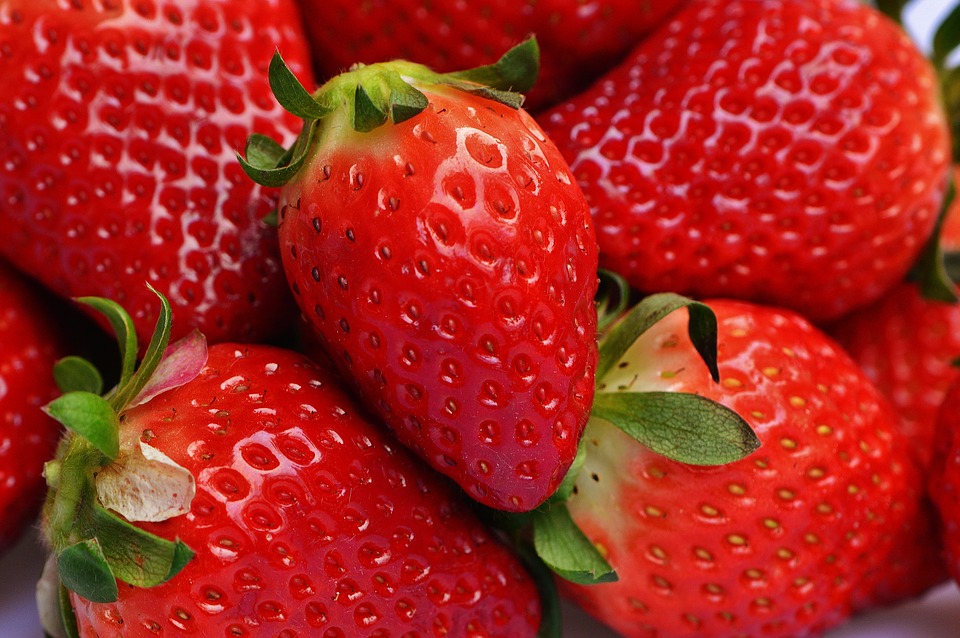This comprehensive guide delves into the fascinating world of strawberries and their suitability for canine consumption. We'll explore their nutritional value, potential risks, and offer practical advice on how to introduce this delicious fruit safely into your furry friend's diet.
Part 1: Unveiling the Nutritional Power of Strawberries

1.1. A Human Delicacy: A Nutritional Overview
Strawberries have long been celebrated for their nutritional prowess. These ruby red gems are brimming with an impressive array of vitamins, minerals, and antioxidants, making them a valuable addition to a healthy human diet.
- Vitamin C: Strawberries are an excellent source of vitamin C, a potent antioxidant that plays a crucial role in boosting the immune system, promoting collagen production, and aiding in wound healing.
- Vitamin K: This vital nutrient plays a key role in blood clotting and bone health. It ensures proper blood coagulation, preventing excessive bleeding, and also contributes to strong bones and teeth.
- Potassium: Strawberries are a good source of potassium, a mineral essential for muscle function, nerve impulses, and blood pressure regulation. Potassium helps maintain electrolyte balance, ensuring optimal muscle contractions and nerve transmissions.
- Folate: This essential B vitamin is crucial for cell division and DNA synthesis. Folate plays a vital role in the formation of red blood cells and the development of healthy cells throughout the body.
- Antioxidants: Strawberries are rich in antioxidants, powerful compounds that protect cells against damage caused by free radicals, which can contribute to chronic diseases.
1.2. Exploring the Benefits for Canines
While the research on the benefits of strawberries for dogs is less extensive than for humans, there's evidence to suggest they can offer various health advantages.
- A Modest Source of Essential Vitamins: Strawberries provide a modest source of vitamins C and K, supporting overall canine health. While not a primary source of these vitamins, they can contribute to a balanced diet.
- Antioxidant Support for Canine Wellness: Their antioxidant content may help combat oxidative stress in dogs, strengthening their immune system and protecting against cell damage.
- Dietary Fiber for Digestive Health: Strawberries are a good source of dietary fiber, aiding digestion and promoting regularity in dogs. Fiber helps regulate bowel movements and can alleviate constipation.
- Hydration for Canine Hydration: Their high water content can contribute to hydration, especially during warmer months. This is particularly beneficial for dogs who may not drink enough water on their own.
Part 2: Deciphering the Safety of Strawberries for Dogs

2.1. General Safety Guidelines for Strawberry Consumption
Strawberries are generally considered safe for dogs when consumed in moderation. However, there are certain factors to keep in mind to ensure their safety.
- Sugar Content: Strawberries contain natural sugars, which should be considered for dogs with diabetes or weight concerns. It's important to monitor their intake and avoid overfeeding.
- Pesticide Residues: Commercially grown strawberries may contain pesticide residues, which can be harmful to dogs. Choosing organic strawberries is highly recommended to minimise this risk.
- Potential Allergic Reactions: Though rare, some dogs may experience allergic reactions to strawberries. Always observe your dog closely after offering them strawberries for any signs of adverse reactions, such as itching, swelling, or difficulty breathing.
2.2. Potential Risks and Cautious Precautions
- Gastrointestinal Upset: Consuming large amounts of strawberries can lead to digestive issues like diarrhoea or vomiting. It's important to introduce strawberries gradually and monitor your dog's reaction.
- Seeds and Leaves: While the strawberry fruit itself is generally safe, the seeds and leaves can cause digestive upset or even blockages in your dog's digestive tract. It's crucial to remove these parts before offering strawberries to your dog.
- Sugar Overload: Feeding excessive amounts of strawberries can contribute to weight gain and dental problems, as the sugar can promote plaque and tartar buildup.
- Strawberry-Based Treats: Commercially available strawberry-based treats often contain added sugars, artificial flavours, and preservatives, which can be harmful to your dog. Opt for natural ingredient treats or homemade options to ensure your dog's well-being.
Part 3: Guiding Your Dog's First Strawberry Experience

3.1. Gradual Introduction for Safety
- Small Amounts: Begin by offering just a few small pieces of strawberry, ensuring your dog tolerates them well before increasing the quantity.
- Monitor for Reactions: Observe for any signs of gastrointestinal upset, allergic reactions, such as itching, hives, or swelling, or behavioural changes.
3.2. Choosing the Right Type of Strawberry
- Organic Options: Opt for organic strawberries to minimise pesticide exposure.
- Fresh or Frozen: Both fresh and frozen strawberries are suitable, offering a refreshing treat. Frozen strawberries can be a good option on warm days as they can help cool your dog down.
3.3. Proper Preparation for Canine Consumption
- Thorough Washing: Wash strawberries thoroughly under running water to remove any dirt or residue. This is especially important for organic strawberries as they may have more dirt clinging to them.
- Remove Seeds and Leaves: Carefully remove all seeds and leaves before offering strawberries to your dog to prevent digestive problems.
- Slice or Chop: Slice or chop strawberries into smaller pieces for easier consumption and to reduce the risk of choking. This is particularly important for smaller dogs.
Part 4: Delicious Strawberry Treats for Your Dog
4.1. Homemade Delights for Canine Palates
- Strawberry-Banana Smoothie: Blend together frozen strawberries, banana, and a little water or plain yoghurt for a refreshing and healthy treat. This smoothie can be especially appealing on warm days.
- Strawberry-Yogurt Bites: Combine mashed strawberries, plain yoghurt, and rolled oats to create healthy and flavourful snacks. This combination provides a good balance of nutrients and fibre.
- Strawberry-Peanut Butter Cookies: For a special occasion, bake homemade cookies with natural peanut butter, oats, and chopped strawberries. Remember to use a recipe specifically designed for dog treats and avoid adding any ingredients that could be harmful to dogs.
4.2. Commercially Available Strawberry Treats
- Natural Ingredient Treats: Choose commercially available treats that contain natural ingredients and avoid artificial colours, flavours, and preservatives.
- Limited Ingredient Treats: Opt for treats with a limited number of ingredients, making it easier to identify potential allergens.
Part 5: Expanding Your Dog's Fruit and Veggie Options
5.1. A Fruit Basket for Your Canine Companion
- Apples: Core and slice apples, removing the seeds to provide a safe and nutritious treat. Apples are a good source of fibre and vitamins.
- Bananas: Offer small slices of bananas, rich in potassium and fibre. Bananas are a good source of energy for dogs.
- Blueberries: These tiny fruits are packed with antioxidants and are generally safe for dogs. Blueberries are a great source of vitamin C and fibre.
- Watermelon: Remove the rind and seeds before offering small pieces of watermelon for hydration and refreshment. Watermelon is a good source of vitamins A and C, as well as electrolytes.
5.2. Vegetables for Canine Wellness
- Carrots: Offer small pieces of raw or cooked carrots, providing a crunchy and nutritious snack. Carrots are a good source of vitamin A and fibre.
- Green Beans: Cooked green beans are a good source of fibre and can be a tasty treat. Green beans are also a good source of vitamins A and C.
- Broccoli: Steam or cook broccoli florets for a healthy and delicious option. Broccoli is a good source of vitamin C and fibre.
Part 6: FAQs about Strawberries and Your Dog
6.1. Can Puppies Enjoy Strawberries?
Puppies can enjoy small amounts of strawberries, but it's essential to introduce them gradually and monitor for any digestive issues. Young puppies may be more susceptible to gastrointestinal upset. It's always best to consult with your veterinarian before introducing any new food to your puppy.
6.2. How Many Strawberries Can My Dog Eat?
The amount of strawberries your dog can safely eat depends on their size, breed, and health condition. As a general rule, a small treat, equivalent to a few slices or a few strawberries, is a good starting point. Avoid overfeeding strawberries to your dog, as it can lead to digestive issues and weight gain.
6.3. Identifying Signs of a Strawberry Allergy in Dogs
Signs of a strawberry allergy in dogs can include vomiting, diarrhoea, itching, hives, swelling, or difficulty breathing. If you observe any of these symptoms after your dog has eaten strawberries, seek immediate veterinary attention.
6.4. Are Strawberry Jam or Preserves Safe for Dogs?
Strawberry jam or preserves contain high amounts of sugar and may also include preservatives. It's best to avoid these products for your dog's health. They can contribute to weight gain, dental problems, and other health issues.
6.5. Are Strawberry Plants or Leaves Safe for My Dog?
Strawberry plants and leaves contain oxalates, which can be toxic to dogs. Avoid offering these parts of the plant to your dog. They can cause kidney problems and other health issues.
6.6. Can Diabetic Dogs Enjoy Strawberries?
Strawberries contain natural sugars, so it's crucial to consult with your veterinarian before offering them to diabetic dogs. They may recommend alternatives with lower sugar content.
It's essential to work closely with your veterinarian to determine the appropriate diet and treat options for your dog, considering their individual needs and health condition. Always err on the side of caution when introducing new foods, starting with small amounts and monitoring for any adverse reactions. By following these guidelines, you can ensure that your dog enjoys the benefits of strawberries while maintaining their overall health and well-being.
Everyone is watching
-

Can Dogs Eat Bananas? A Guide to Safe Treats
DOGS & PUPPIESThis comprehensive guide will delve into the world of canine nutrition, focusing on the popular question: can ...
-

Can Dogs Eat Oranges? (Is It Safe or Toxic?)
DOGS & PUPPIESThis article delves into the question of whether dogs can safely consume oranges. We'll explore the nutrition...
-

Can Dogs Eat Grapes? The Shocking Truth About This Fruit
DOGS & PUPPIESThis article delves into the controversial topic of grapes and dogs, exploring the potential dangers associate...
-

Why Do Dogs Eat Poop? Understanding Coprophagia in Dogs
DOGS & PUPPIESThis article delves into the perplexing phenomenon of coprophagia, the act of eating faeces, in dogs. We explo...
-

Can Dogs Eat Shrimp? A Guide to Safety and Risks
DOGS & PUPPIESThis comprehensive guide dives into the world of shrimp and dogs, exploring the potential benefits and risks a...
